A Stope Mining Design with Consideration of Hanging Wall When Transitioning from Open Pit Mining to Underground Mining for Sepon Gold Mine Deposit, Laos
Abstract
:1. Introduction
2. Geology of Gold and Copper Mineralization at Sepon Mineral District
2.1. Sepon Mineral District
2.2. Geology and the Structural Geology
2.3. Alteration and Mineralization
- Center on RDP intrusion: Cromie [29] has classified four types of alteration in the RDP intrusion centers (i.e., Phadan and Thenkham); (a) K-feldspar dominantly replaced the primary (igneous) plagioclase in the phenocryst and groundmass; (b) white mica with minor chlorite overprinted K-feldspar alteration; (c) quartz vein with K-feldspar alteration halo and later by quartz–chlorite–pyrite–molybdenite–chalcopyrite–bornite–hematite vein; and (d) massive barren quartz vein, vein stockwork. Cu and Mo sulfides are mainly present in the vein quartz and disseminated together with K-feldspar and white mica-chlorite alteration assemblages. However, the grades of Mo and Cu are slightly low, ranging from 40 to 1020 ppm Mo and <0.1 to 0.5% Cu, identifying sub-economic Mo and Cu mineralization in the SMD [30].
- Contact between wall rock lithologies and RDP: the contact between wall rock lithologies, particularly carbonated rocks (e.g., calcareous shale, limestone, and dolomitic limestone) of the Nalou and Kengkuek Formations, as shown in Figure 2, and RDP intrusions resulted in Cu-(Au) skarn mineralization. Cannell, Smith, Cromie, and Seedorff [27,29,31] classified three types of skarn mineralization and alteration assemblage: (a) garnet with minor pyroxene, biotite, and K-feldspar assemblages of prograde skarn, which were overprinted by (b) chlorite, epidote, hematite, calcite, and sulfide (e.g., chalcopyrite–bornite–molybdenite ± Au); and (c) quartz, calcite, fluorite, and pyrite ± Au in the later stage. Primary copper mineralization presented in semi-massive sulfide zones is typically less than 1% Cu, though locally, up to 5% Cu is present in chalcopyrite-rich zones [27]. Lower-grade gold, up to 1 ppm, was identified as a solid solution with chalcopyrite, and higher-grade gold, up to 290 ppm, occurred as a solid solution in pyrite crystal structure during the later stage.
- Sediment-hosted gold deposit: distal distance from the RDP intrusion centers, where the sets of dike and sill intruded calcareous mudstone and calcareous shale of the Discovery Formation presented sediment-hosted gold deposits as shown in Figure 2. Steep faults and secondary shallow to moderately dipping fault structures enhanced the RDP intrusions and elevated hydrothermal fluid ascending, resulting in intensely silicified carbonated rocks or jasperoid and decalcified shale. Gold is predominantly found as invisible gold or gold in solid solution with the crystallization of pyrite, most often disseminated and fracture controlled together with jasperoid and decalcified shale.
2.4. Geotechnical Rock Mass Characterization
3. Numerical Analysis
3.1. The Input Parameters
3.2. Model Construction
4. Results and Discussion
4.1. Surface and Slope Deformations
4.2. Comparison of Different Vein Widths
4.2.1. Yielded Elements
4.2.2. Displacement
4.3. Determined of the Various Stress Ratio
4.4. Different GSI Values
5. Conclusions
- -
- Surface and Slope Deformations: The stability of the slopes was thoroughly examined, revealing a factor of safety (FoS) of approximately 2.46. Displacement monitoring revealed that significant displacement primarily occurred in the hanging wall, while the footwall remained relatively unaffected. This highlights the importance of assessing and managing slope stability, particularly in relation to the hanging wall.
- -
- In the comparison of six different vein widths, the study evaluated six designs for open stope dimensions. The findings revealed that wider open stopes were associated with larger failure zones and higher displacements. On the other hand, narrower designs showed lower potential failure zones, although displacement gradually increased with larger stope sizes. Based on the analysis, it was determined that a stope dimension of 5 × 25 m was considered appropriate. This design struck a balance between avoiding excessive failure risks associated with larger dimensions and ensuring sufficient stability. By selecting this stope dimension, this study aimed to mitigate the potential for significant failures while also taking operational considerations into account.
- -
- Determination of Various Stress Ratios: The impact of different stress ratios on instability around the open stope was analyzed. Lower stress ratios showed relatively low instability, while higher stress ratios above 1.5 led to significant failure zones. The hanging wall side was found to be more prone to failure due to a weaker rock mass. This highlights the need to consider stress ratios and their influence on stability when designing and managing open stopes.
- -
- Different Geological Strength Index (GSI) Values: The geological strength index (GSI) was found to have a notable influence on safety factors and horizontal displacements. Lower GSI values resulted in larger failure zones and higher displacements, while higher GSI values (above 35) improved stability and reduced failure zones [37], particularly in the hanging wall. Understanding the GSI of the rock mass is crucial for assessing stability and implementing appropriate design strategies.
- -
- To ensure stability, it is recommended that the crown pillar thickness not be less than 40–50 m and the sill pillar have a minimum thickness of 5 m. These recommendations are based on the geological conditions specific to the mine and are essential for maintaining the stability of the underground workings.
Author Contributions
Funding
Data Availability Statement
Acknowledgments
Conflicts of Interest
References
- Soltani Khaboushan, A.; Osanloo, M.; Esfahanipour, A. Optimization of open pit to underground transition depth: An idea for reducing waste rock contamination while maximizing economic benefits. J. Clean. Prod. 2020, 277, 123530. [Google Scholar] [CrossRef]
- Bakhtavar, E.; Shahriar, K.; Oraee, K. Transition from open-pit to underground as a new optimization challenge in mining engineering. J. Min. Sci. 2009, 45, 485–494. [Google Scholar] [CrossRef]
- Bakhtavar, E.; Shahriar, K.; Mirhassani, A. Optimization of the transition from open-pit to underground operation in combined mining using (0-1) integer programming. J. S. Afr. Inst. Min. Metall. 2012, 112, 1059–1064. [Google Scholar]
- Potvin, Y.; Hudyma, M. Open Stope Mining in Canada Yves Potvin and Marty Hudyma Australian Centre for Geomechanics. In Proceedings of the MassMin, Brisbane, Australia, 29 October–2 November 2000. [Google Scholar]
- Chung, J.; Asad, M.W.A.; Topal, E. Timing of transition from open-pit to underground mining: A simultaneous optimisation model for open-pit and underground mine production schedules. Resour. Policy 2022, 77, 102632. [Google Scholar] [CrossRef]
- Olavarría, S.; Adriasola, P.; Karzulovic, A. Transition from open pit to underground mining at chuquicamata, Antofagasta, Chile. In International Symposium of Stability of Rock Slopes in Open Pit Mining and Civil Engineering; The South African Institute of Mining and Metallurgy: Johannesburg, South Africa, 2015; pp. 421–434. [Google Scholar]
- Eberhardt, E.; Woo, K.; Stead, D.; Elmo, D. Transition from surface to underground mining: Integrated mapping, monitoring and modeling data to better understand complex rock mass interaction. In Proceedings of the International Symposium on Rock Slope Stability in Open Pit Mining and Civil Engineering, Perth, Australia, 12–14 September 2007; pp. 321–332. [Google Scholar]
- Opoku, S.; Musingwini, C. Stochastic modelling of the open pit to underground transition interface for gold mines. Int. J. Min. Reclam. Environ. 2013, 27, 407–424. [Google Scholar] [CrossRef]
- Roberts, B.; Elkington, T.; Van Olden, K.; Maulen, M. Optimising combined open pit and underground strategic plan. Trans. Inst. Min. Metall. Sect. A Min. Technol. 2013, 122, 94–100. [Google Scholar] [CrossRef]
- Bakhtavar, E. Op-Ug TD Optimizer Tool Based on Matlab Code to Find Transition Depth from Open Pit to Block Caving. Arch. Min. Sci. 2015, 60, 687–695. [Google Scholar] [CrossRef]
- Bakhtavar, E.; Shahriar, K.; Oraee, K. Mining method selection and optimization of transition from open pit to underground in combined mining. Arch. Min. Sci. 2009, 54, 481–493. [Google Scholar]
- King, B.; Goycoolea, M.; Newman, A. Optimizing the open pit-to-underground mining transition. Eur. J. Oper. Res. 2017, 257, 297–309. [Google Scholar] [CrossRef]
- Ordin, A.A.; Vasil’ev, I.V. Optimized depth of transition from open pit to underground coal mining. J. Min. Sci. 2014, 50, 696–706. [Google Scholar] [CrossRef]
- Ben-Awuah, E.; Richter, O.; Elkington, T. Mining options optimization: Concurrent open pit and underground mining production scheduling. In Proceedings of the 37th International Symposium on the Application of Computers and Operations Research in the Mineral Industry, Fairbanks, AK, USA, 23–25 May 2015; pp. 23–27. [Google Scholar]
- Whittle, D.; Brazil, M.; Grossman, P.A.; Rubinstein, J.H.; Thomas, D.A. Combined optimisation of an open-pit mine outline and the transition depth to underground mining. Eur. J. Oper. Res. 2018, 268, 624–634. [Google Scholar] [CrossRef]
- Bakhtavar, E.; Abdollahisharif, J.; Aminzadeh, A. A stochastic mathematical model for determination of transition time in the non-simultaneous case of surface and underground mining. J. S. Afr. Inst. Min. Metall. 2017, 117, 1145–1153. [Google Scholar] [CrossRef] [Green Version]
- Afum, B.O.; Ben-Awuah, E. Open pit and underground mining transitions planning: A MILP framework for optimal resource extraction evaluation. In Proceedings of the Application of Computers and Operations Research (APCOM), Wroclaw, Poland, 4–6 June 2019. [Google Scholar]
- Afum, B.O.; Ben-Awuah, E.; Askari-Nasab, H. A mixed integer linear programming framework for optimising the extraction strategy of open pit–underground mining options and transitions. Int. J. Min. Reclam. Environ. 2020, 34, 700–724. [Google Scholar] [CrossRef]
- Ma, F.; Zhao, H.; Zhang, Y.; Guo, J.; Wei, A.; Wu, Z.; Zhang, Y. GPS monitoring and analysis of ground movement and deformation induced by transition from open-pit to underground mining. J. Rock Mech. Geotech. Eng. 2012, 4, 82–87. [Google Scholar] [CrossRef] [Green Version]
- Yardimci, A.G.; Tutluoglu, L.; Karpuz, C. Crown pillar optimization for surface to underground mine transition in Erzincan/Bizmisen iron mine. In Proceedings of the 50th U.S. Rock Mechanics/Geomechanics Symposium, Houston, TX, USA, 26–29 June 2016. p. ARMA-2016. [Google Scholar]
- Afum, B.O.; Ben-Awuah, E. A Review of Models and Algorithms for Surface-Underground Mining Options and Transitions Optimization: Some Lessons Learnt and the Way Forward. Mining 2021, 1, 112–134. [Google Scholar] [CrossRef]
- MacNeil, J.A.L.; Dimitrakopoulos, R.G. A stochastic optimization formulation for the transition from open pit to underground mining. Optim. Eng. 2017, 18, 793–813. [Google Scholar] [CrossRef]
- Hamman, E.; Cowan, M.; Venter, J.; de Souza, J. Considerations for open pit to underground transition interaction. In Proceedings of the 2020 International Symposium on Slope Stability in Open Pit Mining and Civil Engineering, Perth, Australian, 12–14 May 2020; pp. 1123–1138. [Google Scholar] [CrossRef]
- Potvin, Y. Empirical Open Stope Design in Canada. A Thesis Submitted in Partial Fulfillment of the Requirements for the Degree of Doctor of Philosophy in the Faculty of Graduate Studies Department of Mining And Mineral Process Engineering. Ph.D. Thesis, University of British Columbia, Vancouver, BC, Canada, 1988. [Google Scholar]
- Hudson, J.A.; Harrison, J.P. 13-Rock dynamics and time-dependent aspects. In Engineering Rock Mechanics; Pergamon: Oxford, UK, 1997; pp. 207–221. [Google Scholar]
- Smith, S.; Olberg, D.; Manini, T. The Sepon gold deposits, Laos: Exploration, geology and comparison to Carlin-type gold deposits in the Great Basin. In Symposium 2005 Window to the World; Geological Society of Nevada: Reno, NV, USA, 2005; pp. 899–915. [Google Scholar]
- Cannell, J.; Smith, S. High-grade supergene enriched and exotic copper deposits in the Sepon Mineral District, Lao PDR. In Proceedings of the PACRIM Congress, Gold Coast, Australia, 24–26 January 2008; pp. 355–361. [Google Scholar]
- Loader, S.E. Supergene enrichment of the Khanong copper resource, Sepon project, Lao PDR. PACRIM 1999, 99, 263–270. [Google Scholar]
- Cromie, P. Geological Setting, Geochemistry and Genesis of the Sepon Gold and Copper Deposits, Laos. Ph.D. Thesis, ARC Centre of Excellence in Ore Deposits (CODES), University of Tasmania, Hobart, Austalia, 2010; 395p. (Unpublished Thesis). [Google Scholar]
- LXML. Drill Hole Report; LXML: Vientiane, Laos, 1999; Unpublished company report. [Google Scholar]
- Seedorff, E.; Dilles, J.H.; Proffett, J.M.; Einaudi, M.T.; Zurcher, L.; Stavast, W.J.A.; Johnson, D.A.; Barton, M.D. Porphyry Deposits: Characteristics and Origin of Hypogene Features: Economic Geology 100th Anniversary; Society of Economic Geologists: Littleton, CO, USA, 2005; pp. 251–298. [Google Scholar] [CrossRef]
- Marinos, P.; Hoek, E. GSI: A geologically friendly tool for rock mass strength estimation. In Proceedings of the ISRM International Symposium, Melbourne, Australia, 19–24 November 2000. p. ISRM-IS-2000-035. [Google Scholar]
- Hoek, E.; Carter, T.G.; Diederichs, M.S. Quantification of the geological strength index chart. In Proceedings of the 47th U.S. Rock Mechanics/Geomechanics Symposium, San Francisco, CA, USA, 23–26 June 2013; Volume 3, pp. 1757–1764. [Google Scholar]
- Sasaoka, T.; Takamoto, H.; Shimada, H.; Oya, J.; Hamanaka, A.; Matsui, K. Surface subsidence due to underground mining operation under weak geological condition in Indonesia. J. Rock Mech. Geotech. Eng. 2015, 7, 337–344. [Google Scholar] [CrossRef] [Green Version]
- Guggari, V.B.; Kumar, H.; Budi, G. Numerical analysis for assessing the effects of crown pillar thickness on ore dilution around the sub-level open stopes. Ain Shams Eng. J. 2023, 102301. [Google Scholar] [CrossRef]
- Vakili, A. An improved unified constitutive model for rock material and guidelines for its application in numerical modelling. Comput. Geotech. 2016, 80, 261–282. [Google Scholar] [CrossRef]
- Thae, C.; Dyson, O.; Takashi, M.; Hideki, S. Design and Stope Stability Analysis of Multiple Concurrent Excavated Veins in Underground Mine; Case Study of Hermyingyi Tin-Tungsten (W-Sn) Mine. Geotech. Geol. Eng. 2022, 41, 1049–1072. [Google Scholar] [CrossRef]
- Dintwe, T.K.M.; Sasaoka, T.; Shimada, H.; Hamanaka, A.; Moses, D.; Liu, S.; Meng, F. Effects of Sublevel Open Stope Underground Mining on Surface and Open Pit Slopes. J. Geosci. Environ. Prot. 2021, 9, 121–131. [Google Scholar] [CrossRef]
- Purwanto, H.S.; Shimada, H.; Sasaoka, T.; Wattimena, R.K.; Matsui, K. Influence of Stope Design on Stability of Hanging Wall Decline in Cibaliung Underground Gold Mine. Int. J. Geosci. 2013, 4, 1–8. [Google Scholar] [CrossRef] [Green Version]
- Sepehri, M.; Apel, D.; Liu, W. Stope Stability Assessment and Effect of Horizontal to Vertical Stress Ratio on the Yielding and Relaxation Zones Around Underground Open Stopes Using Empirical and Finite Element Methods. Arch. Min. Sci. 2017, 62, 653–669. [Google Scholar] [CrossRef] [Green Version]
- Kaiser, P.K.; Yazici, S.; Maloney, S. Mining-induced stress change and consequences of stress path on excavation stability—A case study. Int. J. Rock Mech. Min. Sci. 2001, 38, 167–180. [Google Scholar] [CrossRef]

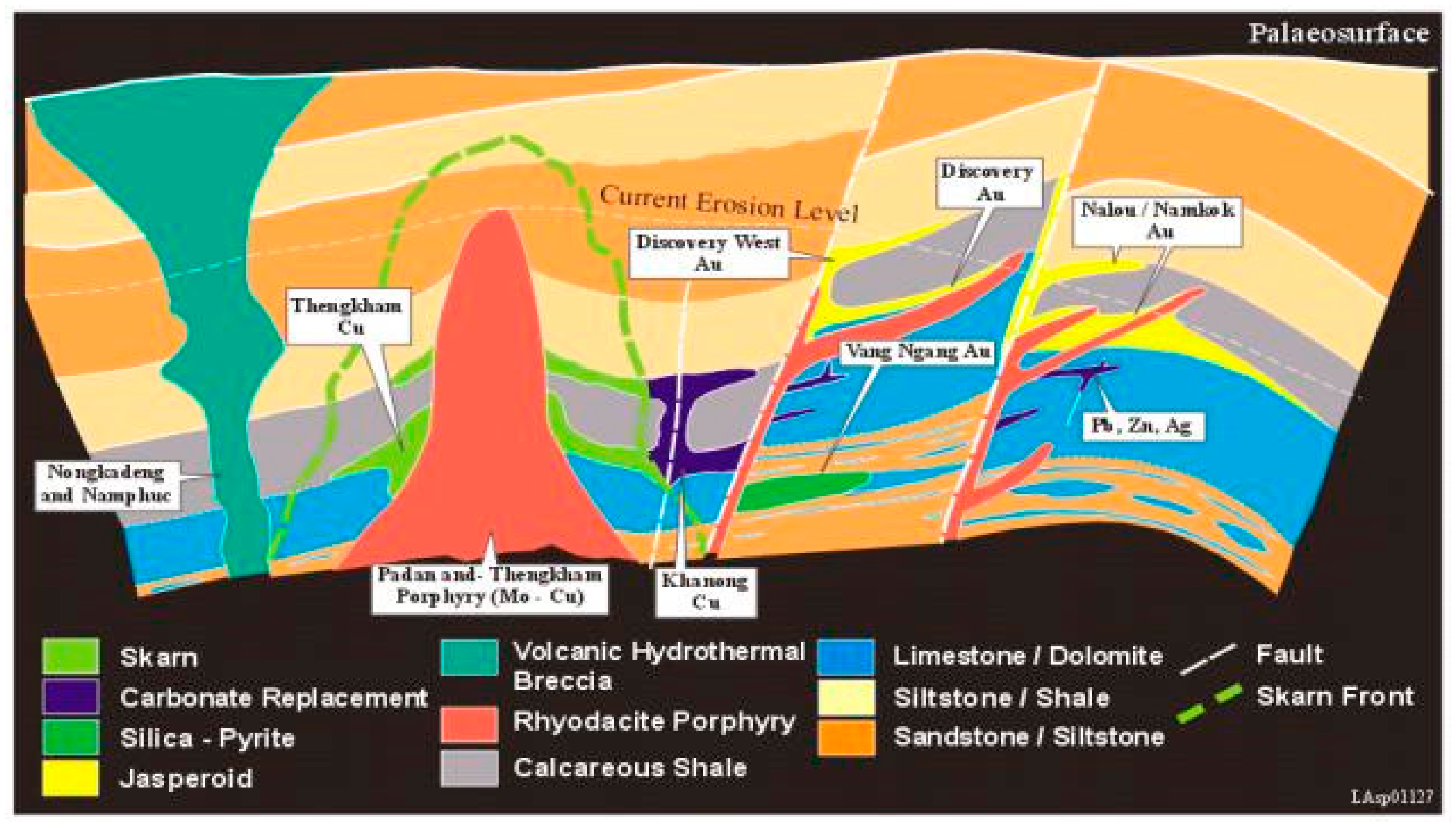

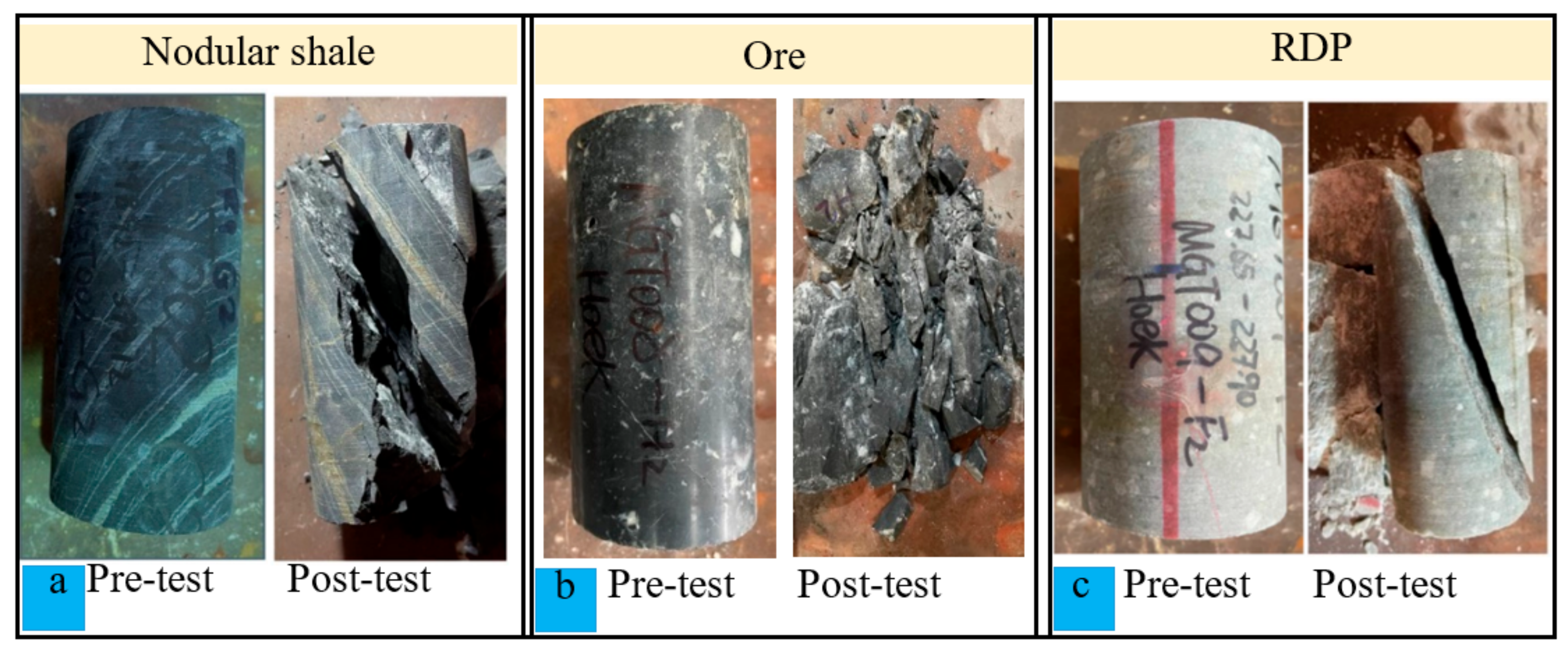
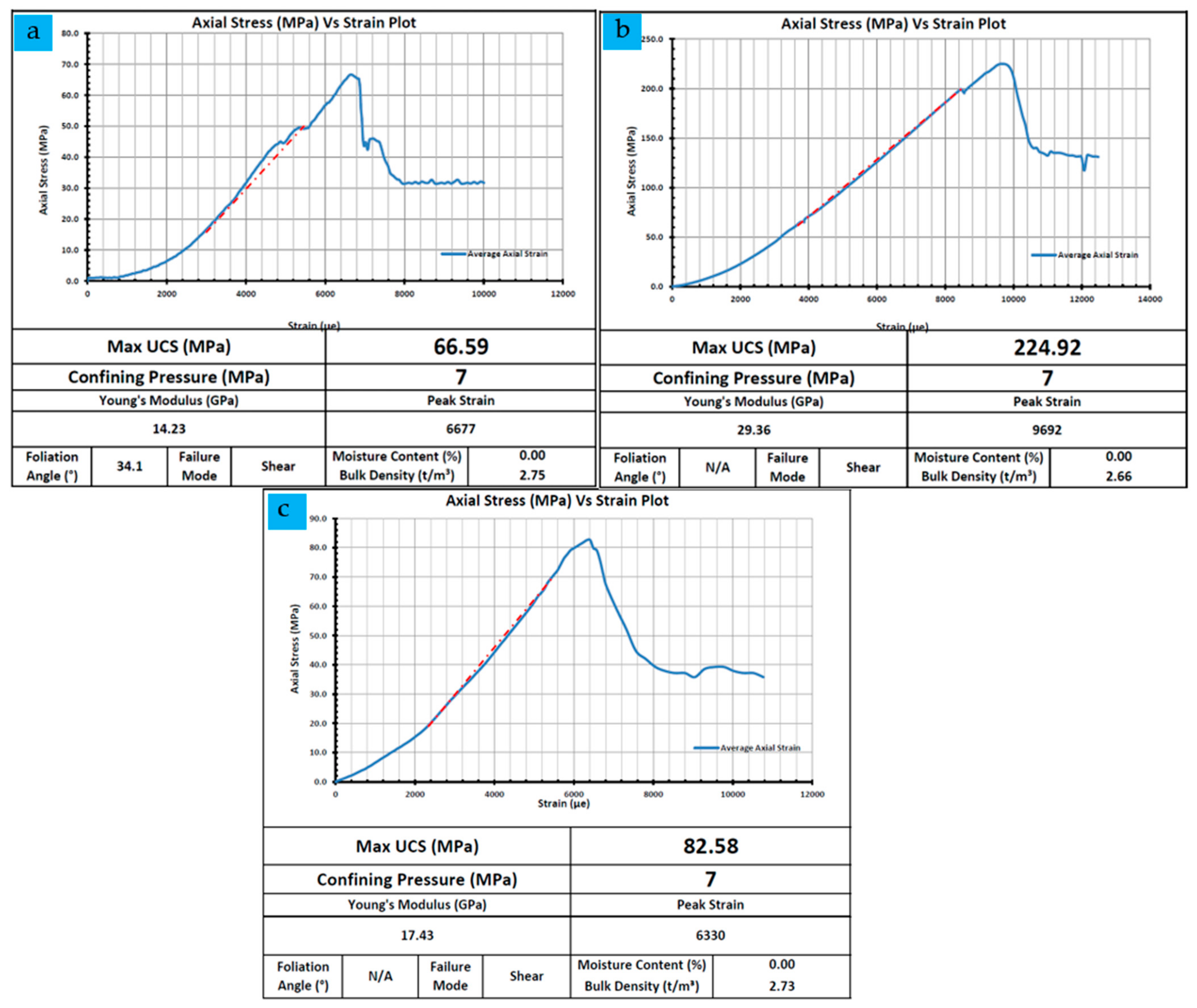

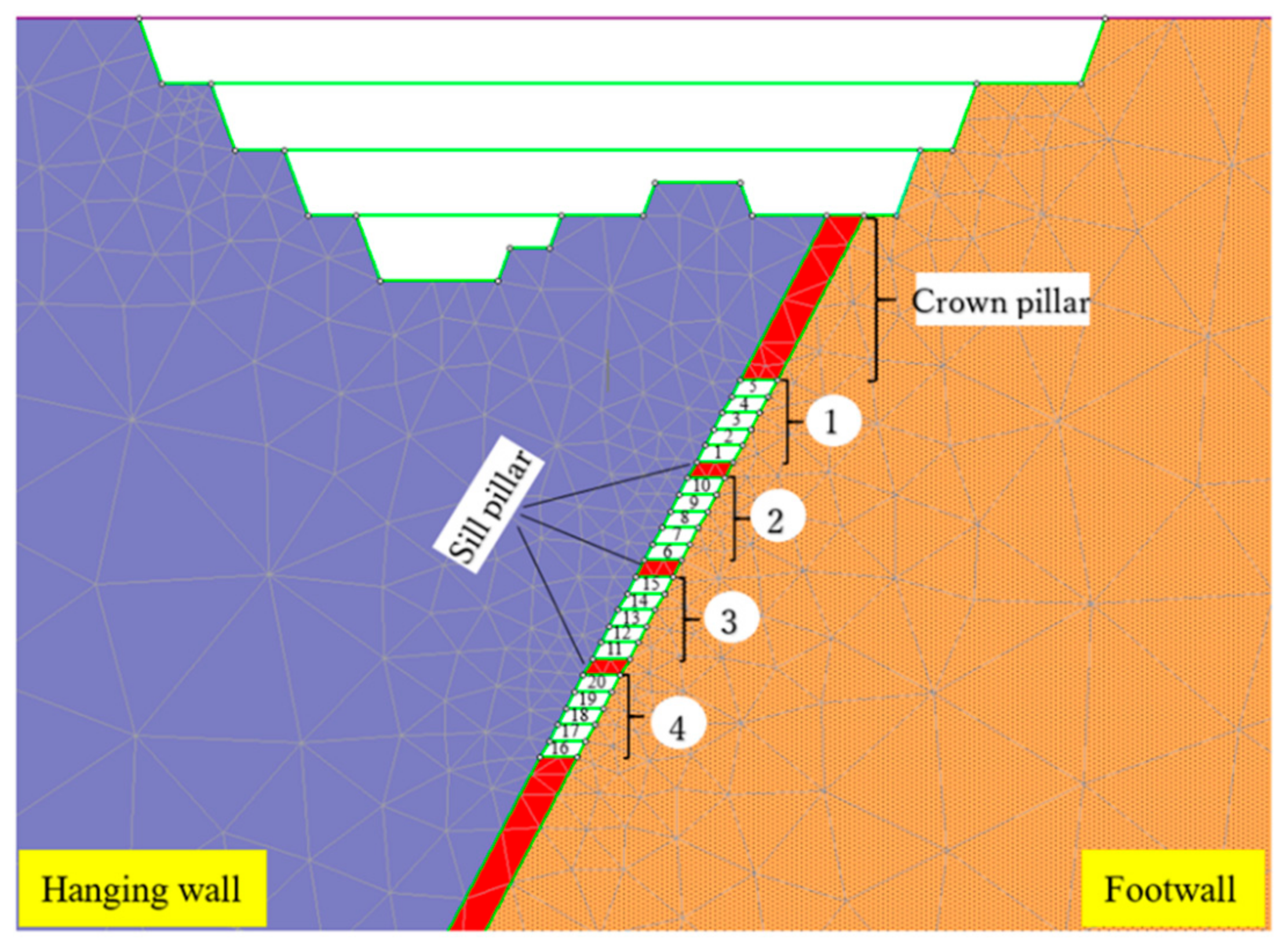
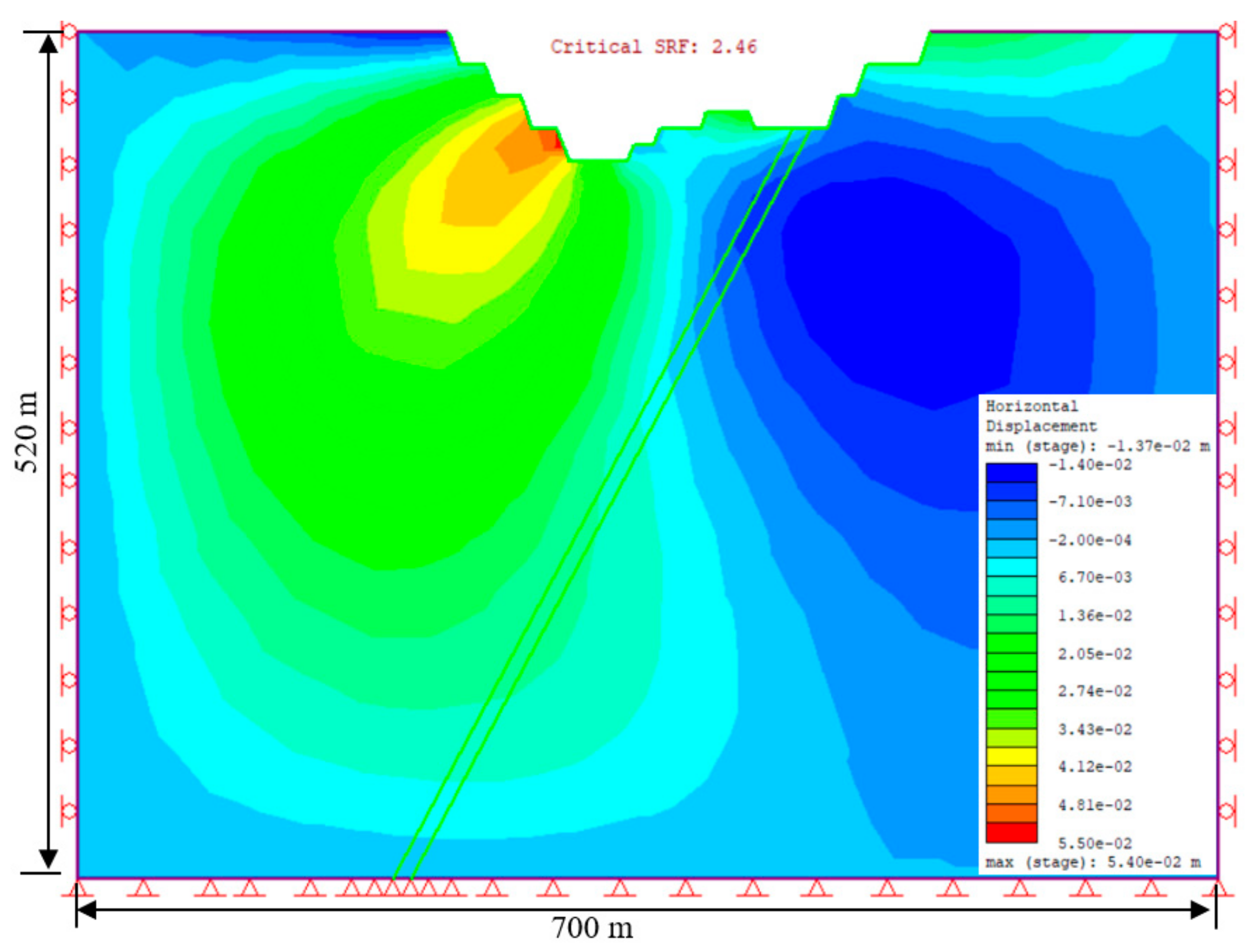
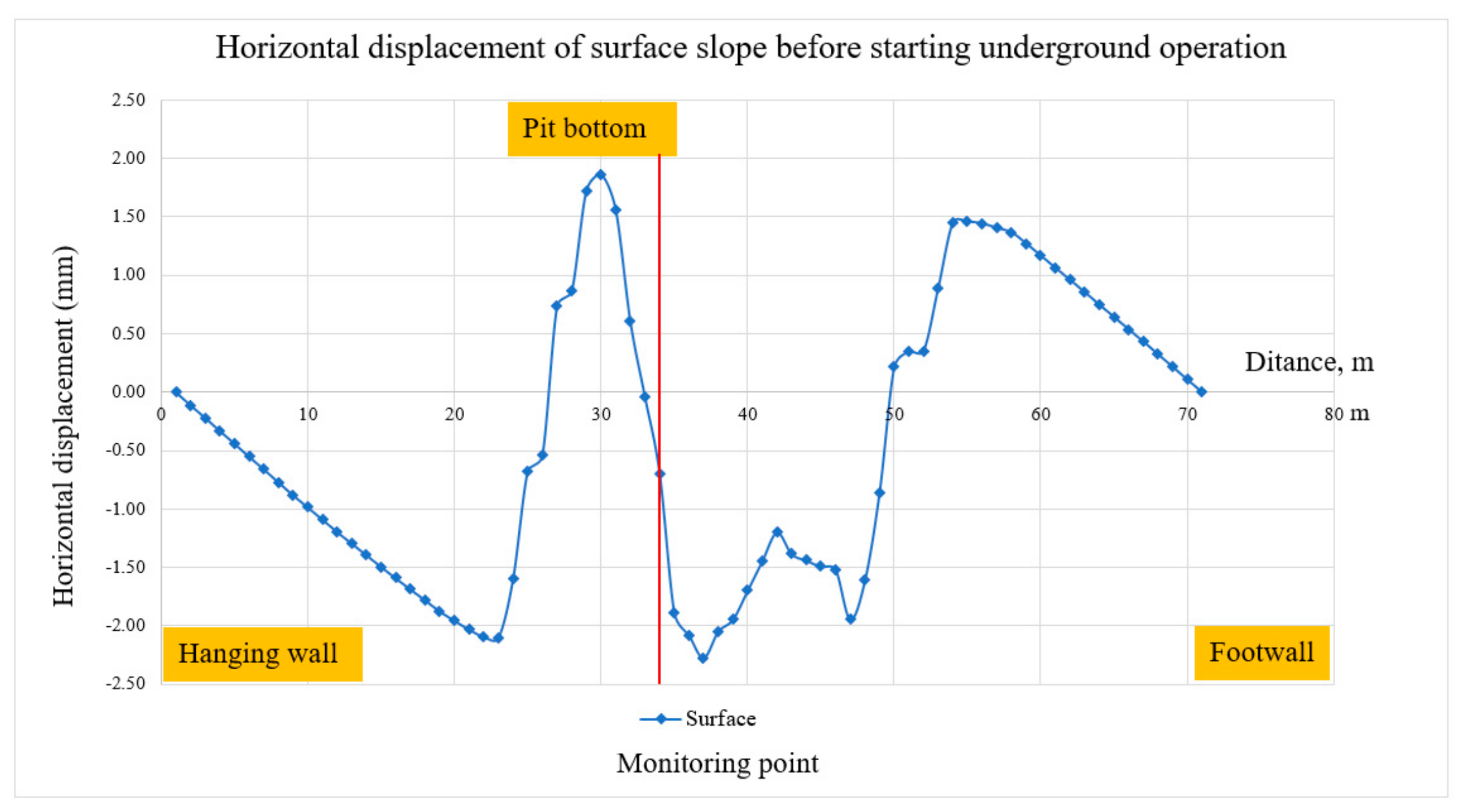


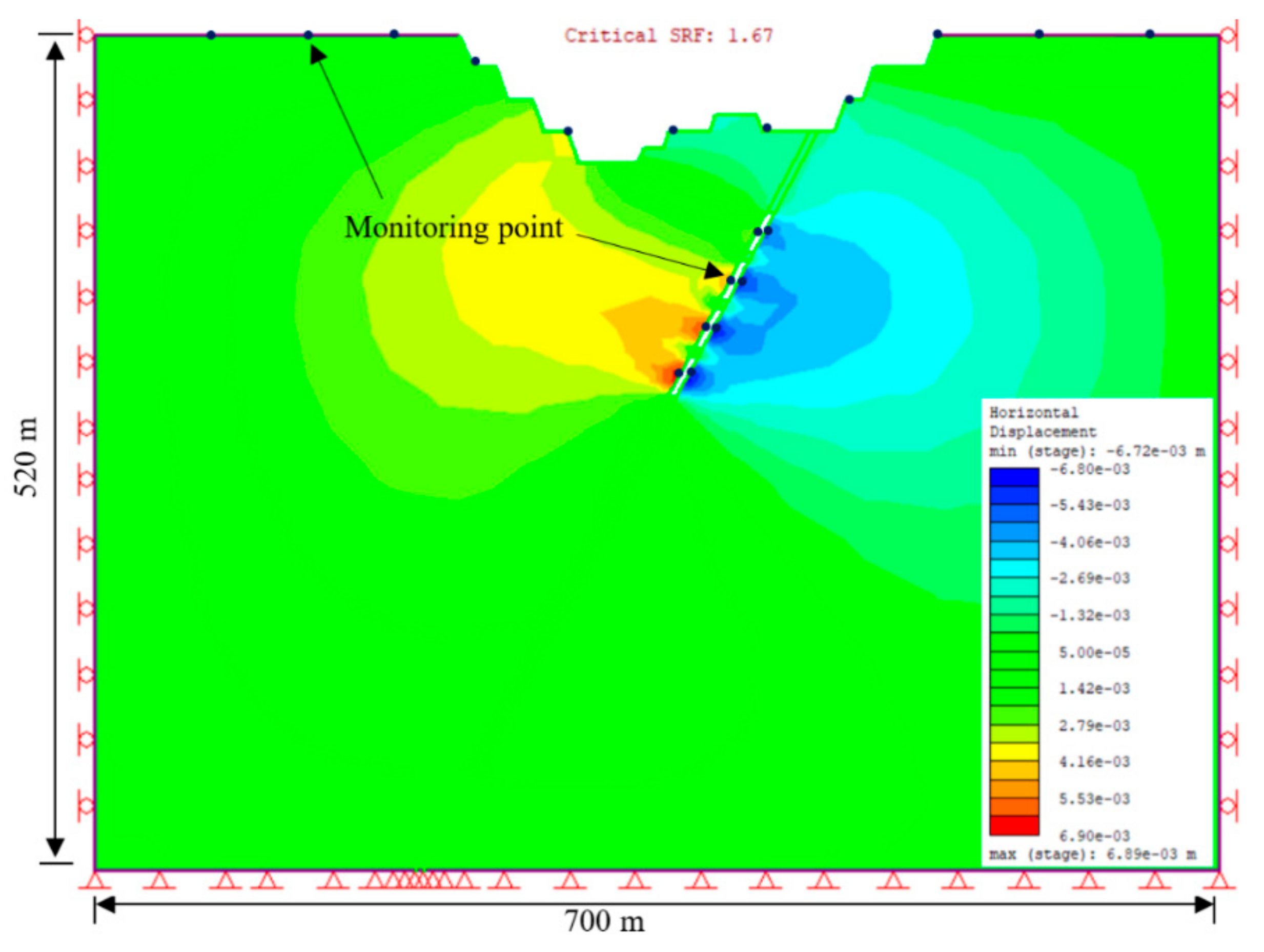


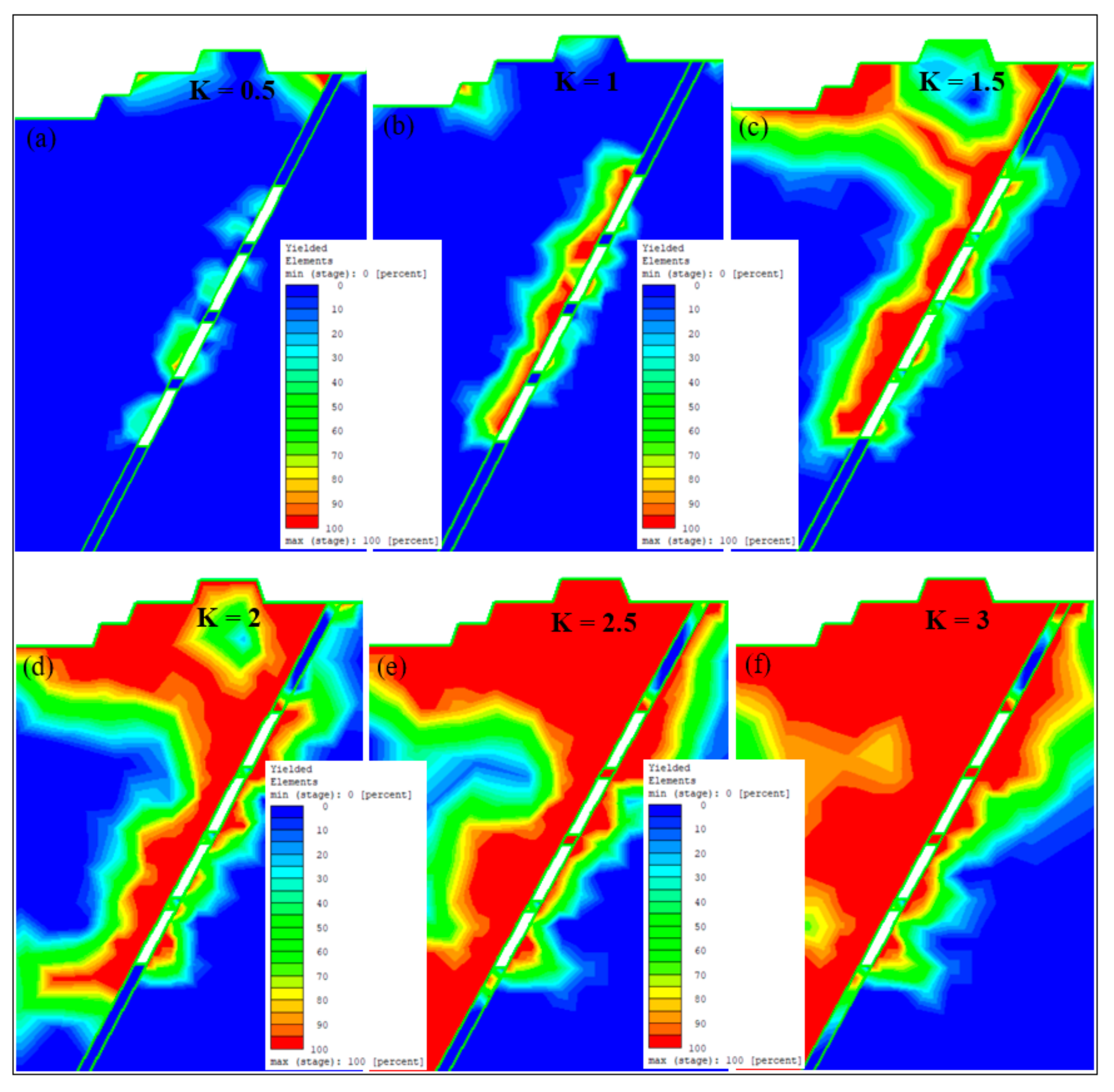


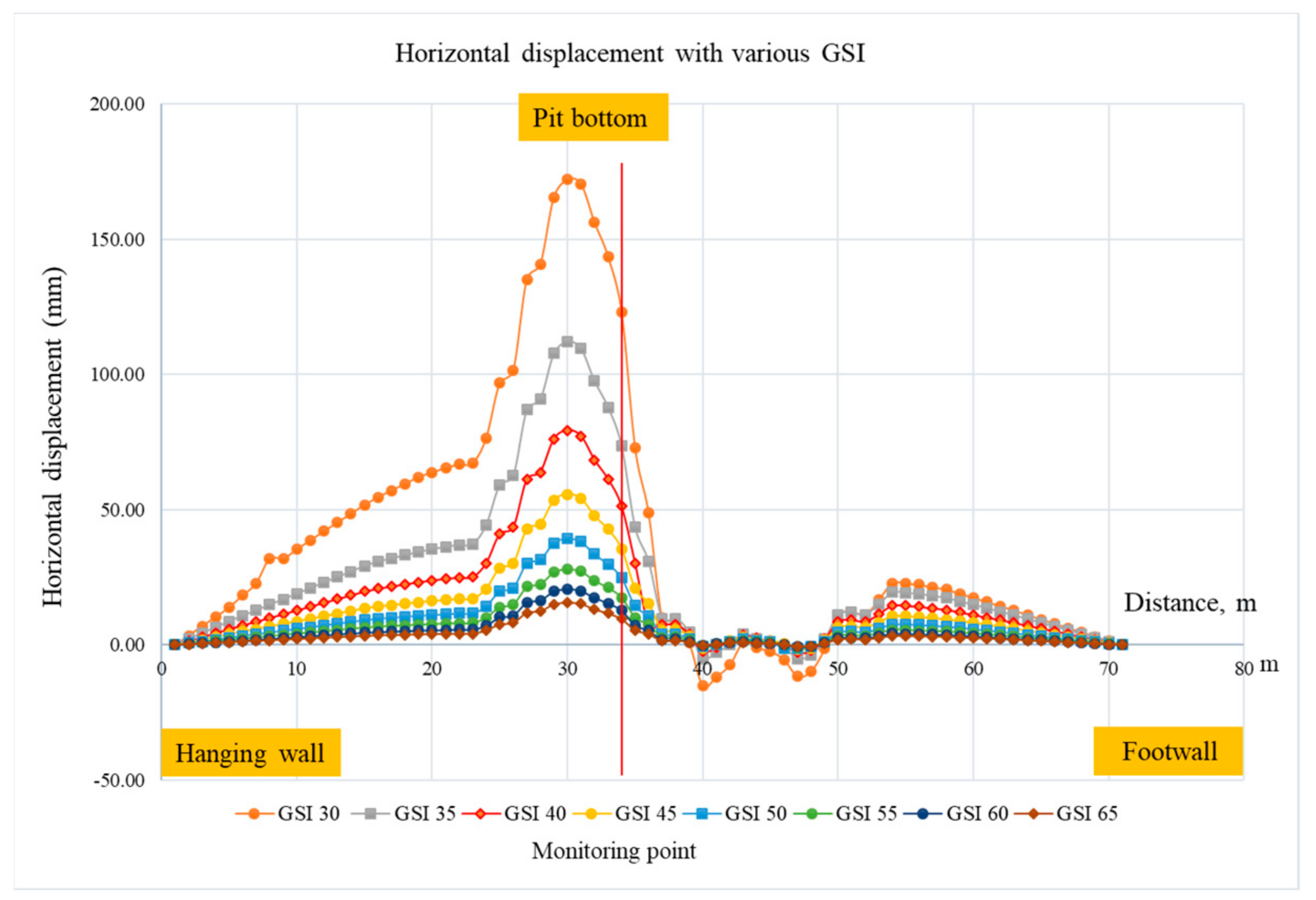
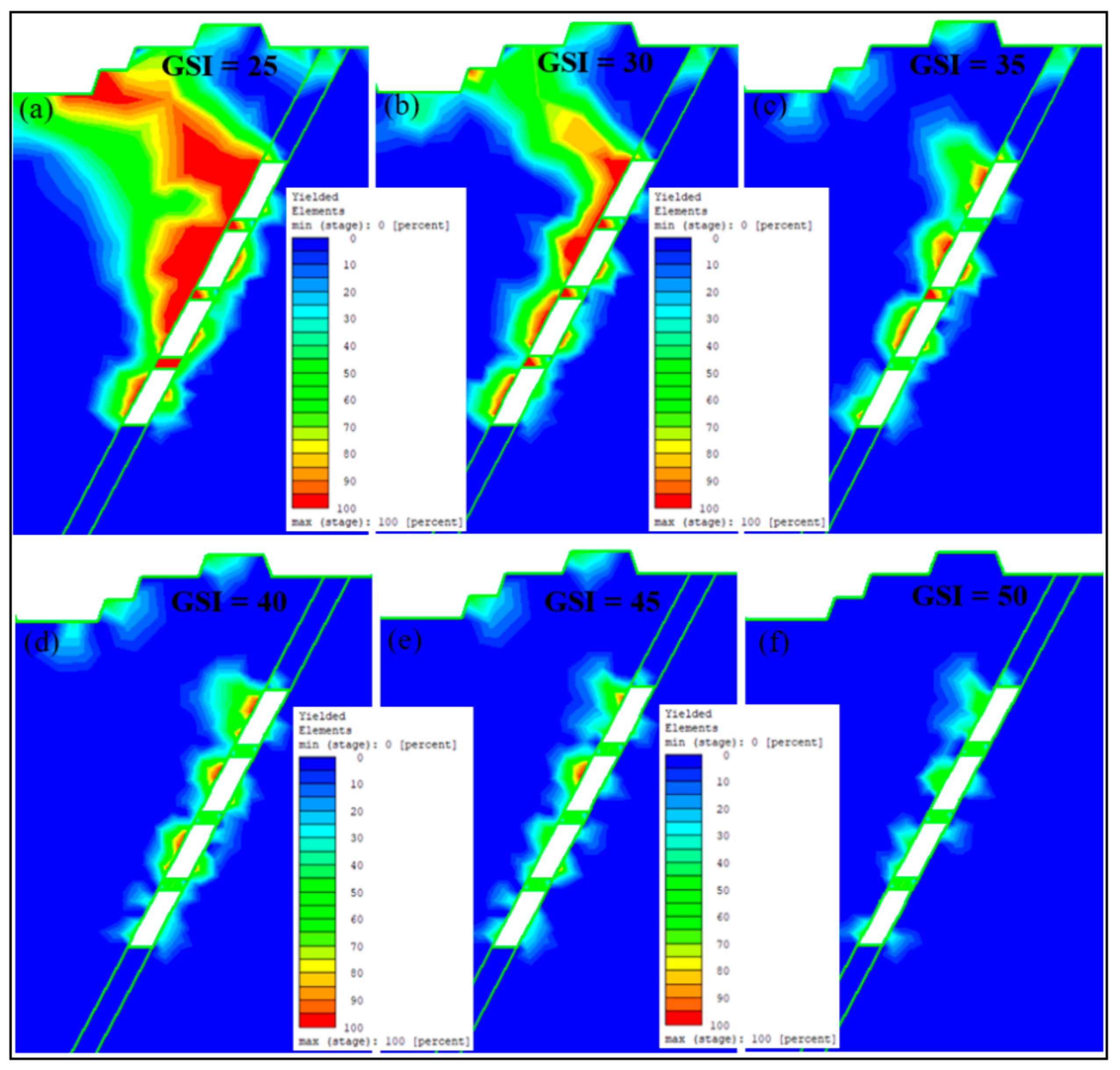
| Geological Strength Index (GSI) | Zone/Rock Type | Unit Weight (MN/m3) | σci (MPa) | Tensile Strength (MPa) | Erm (GPa) | v | Hoek Brown Parameter | ||
|---|---|---|---|---|---|---|---|---|---|
| mb | s | a | |||||||
| 72 | Footwall RDP | 0.0275 | 82.58 | 15.59 | 17.43 | 0.3 | 6.167 | 0.0315 | 0.501 |
| 62 | Ore body | 0.0266 | 224.92 | 13.81 | 29.36 | 0.3 | 2.656 | 0.010 | 0.502 |
| 51 | Hanging wall Nodular shale | 0.0279 | 66.59 | 11.66 | 14.23 | 0.35 | 0.898 | 0.001 | 0.505 |
Disclaimer/Publisher’s Note: The statements, opinions and data contained in all publications are solely those of the individual author(s) and contributor(s) and not of MDPI and/or the editor(s). MDPI and/or the editor(s) disclaim responsibility for any injury to people or property resulting from any ideas, methods, instructions or products referred to in the content. |
© 2023 by the authors. Licensee MDPI, Basel, Switzerland. This article is an open access article distributed under the terms and conditions of the Creative Commons Attribution (CC BY) license (https://creativecommons.org/licenses/by/4.0/).
Share and Cite
Phaisopha, S.; Shimada, H.; Sasaoka, T.; Hamanaka, A.; Pongpanya, P.; Shorin, S.; Senthavisouk, K. A Stope Mining Design with Consideration of Hanging Wall When Transitioning from Open Pit Mining to Underground Mining for Sepon Gold Mine Deposit, Laos. Mining 2023, 3, 463-482. https://doi.org/10.3390/mining3030027
Phaisopha S, Shimada H, Sasaoka T, Hamanaka A, Pongpanya P, Shorin S, Senthavisouk K. A Stope Mining Design with Consideration of Hanging Wall When Transitioning from Open Pit Mining to Underground Mining for Sepon Gold Mine Deposit, Laos. Mining. 2023; 3(3):463-482. https://doi.org/10.3390/mining3030027
Chicago/Turabian StylePhaisopha, Seelae, Hideki Shimada, Takashi Sasaoka, Akihiro Hamanaka, Phanthoudeth Pongpanya, Seva Shorin, and Khounma Senthavisouk. 2023. "A Stope Mining Design with Consideration of Hanging Wall When Transitioning from Open Pit Mining to Underground Mining for Sepon Gold Mine Deposit, Laos" Mining 3, no. 3: 463-482. https://doi.org/10.3390/mining3030027





